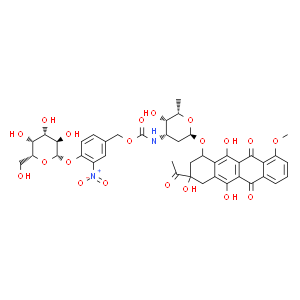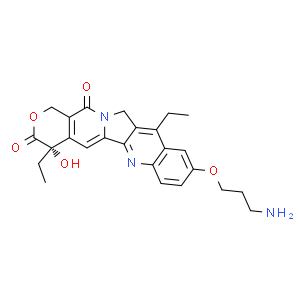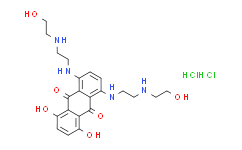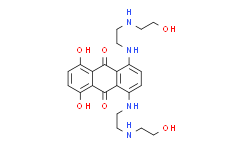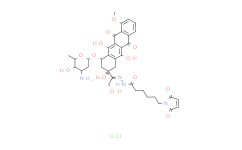| 中文名称: | Daun02 | ||||
|---|---|---|---|---|---|
| 英文名称: | Daun02 | ||||
| 别名: | (8S,10S)-8-乙酰基-7,8,9,10-四氢-6,8,11-三羟基-1-甲氧基-10-[[2,3,6-三脱氧-3-[[[[4-(beta-D-吡喃半乳糖基氧基)-3-硝基苯基]甲氧基]羰基]氨基]-alpha-L-来苏-己糖吡喃糖苷]氧基]-5,12-并四苯醌 [3-Nitro-4-[(2S,3R,4S,5R,6R)-3,4,5-trihydroxy-6-(hydroxymethyl)oxan-2-yl]oxyphenyl]methyl N-[(2S,3S,4S,6R)-6-[[(1S,3S)-3-acetyl-3,5,12-trihydroxy-10-methoxy-6,11-dioxo-2,4-dihydro-1H-tetracen-1-yl]oxy]-3-hydroxy-2-methyloxan-4-yl]carbamate | ||||
| CAS No: | 290304-24-4 | 分子式: | C41H44N2O20 | 分子量: | 884.8 |
| CAS No: | 290304-24-4 | ||||
| 分子式: | C41H44N2O20 | ||||
| 分子量: | 884.8 | ||||
基本信息
|
产品编号: |
D10579 |
||||
|
产品名称: |
Daun02 |
||||
|
CAS: |
储存条件 |
粉末 |
-20℃ |
四年 |
|
|
|
|
||||
|
分子式: |
溶于液体 |
-80℃ |
六个月 |
||
|
分子量 |
884.80 |
-20℃ |
一个月 |
||
|
化学名: |
|||||
|
Solubility (25°C): |
|||||
|
体外:
|
DMSO |
≥ 100mg/mL (113.02mM) |
|||
|
Ethanol |
|
||||
|
Water |
|
||||
|
体内(现配现用): |
1.请依序添加每种溶剂:10% DMSO-40% PEG300 -5% Tween-80-45% saline, Solubility: ≥ 2.5mg/mL (2.83mM); Clear solution |
||||
|
此⽅案可获得≥2.5mg/mL(2.83mM,饱和度未知)的澄清溶液。以1mL⼯作液为例,取100μL25.0mg/mL的澄清DMSO储备液加到400μLPEG300中,混合均匀;向上述体系中加⼊50μLTween-80,混合均匀;然后继续加⼊450μL⽣理盐⽔定容⾄1mL。 |
|||||
|
<1mg/ml表示微溶或不溶。 |
|||||
|
普西唐提供的所有化合物浓度为内部测试所得,实际溶液度可能与公布值有所偏差,属于正常的批间细微差异现象。 |
|||||
|
请根据产品在不同溶剂中的溶解度选择合适的溶剂配制储备液;⼀旦配成溶液,请分装保存,避免反复冻融造成的产品失效。 |
|||||
制备储备液
|
浓度
溶液体积 质量 |
1mg |
5mg |
10mg |
|
1mM |
1.1302mL |
5.6511mL |
11.3021mL |
|
5mM |
0.2260mL |
1.1302mL |
2.2604mL |
|
10mM |
0.1130mL |
0.5651mL |
1.1302mL |
生物活性
|
产品描述 |
一种拓扑异构酶抑制剂Daunorubicin的前药。 |
|
|
靶点 |
Topoisomerase |
Daunorubicins/Doxorubicins |
|
体外研究 |
Daun02 is a prodrug, which is converted by β-galactosidase to Daunorubicin, which has been shown to reduce calcium ion (Ca2+)-dependent action potentials in neuroblastoma cells. Daunorubicin is a topoisomerase inhibitor. Daun02 is a good substrate for β-galactosidase (β-gal). The concentration of Daun02 producing 50% (EC50) decrease in cell viability is 0.5μM, 1.5μM, and 3.5μM for T47-D, Panc02, and MCF-7, respectively |
|
|
体内研究 |
Daun02 is a good substrate for β-gal with Km and Vmax values of 0.37mM and 8.6μMol/min/mg protein. At a concentration of 10-5 M, Daun02 is 79% bound to plasma protein compares to 94% for Daunomycin |
|
推荐实验方法(仅供参考)
|
Cell Assay |
Murine Panc02 cells are maintained as exponentiallygrowing monolayer cultures in DMEM/F12 or RPMI-1640 medium supplemented with 10% FBS, 1% glutamine, penicillin, and streptomycin at 37°C. For cytotoxicity assay, the cells are seeded into 96-well microplates and incubated overnight. Initial experiments indicate that FBS contains low levels of intrinsic β-gal activity as evidenced by the slow conversion of Daun02 to Daunomycin; however, this is not evident for human serum. Therefore, prior to addition of Daun02, the FBS concentration is reduced from 10% to 1% for Panc02 cells. Human serum (10%) is used for the transduced human cell lines. The cells are incubated for 24 h and then MTT is added. Lysis buffer (20% SDS dissolved in 50% DMF) is added 4 h after the addition of MTT and the cells are incubated overnight. The optical density at 570 nm is determined using a BIO-RAD microplate reader. Cytotoxicity is expressed as the concentration of drug or prodrug that produced a 50% (EC50) reduction in cell viability |
|
Animal Administration |
Mice Male athymic BALB/c mice (nu/nu genotype, 18-20 g) are used. Daunomycin is administered at a dose of 20 mg/kg in 100μL normal saline solution into the tail vein. Daun02 is administered intraperitoneallyat a dose of 200 mg/kg in 200μL vehicle. (This route is selected because the volume of drug solution, 200μL, is too great for tail vein administration.) Tumor volume is determined bycaliper measurement in two dimensions and converted to tumor mass. Tumor growth is monitored over a period of 30 days or until the tumors has reached a mass of 5% of bodyweight (about 1 g). The animals are then killed bycarbon dioxide asphyxiation. |
本计算器可帮助您计算出特定溶液中溶质的质量、溶液浓度和体积之间的关系,公式为:
质量 (g) = 浓度 (mol/L) x 体积 (L) x 分子量 (g/mol)
摩尔浓度计算公式
用本工具协助配置特定浓度的溶液,使用的计算公式为:
开始浓度 x 开始体积 = 最终浓度 x 最终体积
稀释公式
稀释公式一般简略地表示为:C1V1 = C2V2 ( 输入 输出 )


